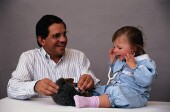- Skip Storing This Everyday Product in the Fridge Door
- Green Tea + B3 Pairing May Boost Brain Health
- Navigating Your Midlife Crisis: Embracing New Possibilities
- City Raccoons Showing Signs of Domestication
- Mapping the Exposome: Science Broadens Focus to Environmental Disease Triggers
- One Week Less on Social Media Linked to Better Mental Health
- Your Brain Changes in Stages as You Age, Study Finds
- Some Suicide Victims Show No Typical Warning Signs, Study Finds
- ByHeart Formula Faces Lawsuits After Babies Sickened With Botulism
- Switch to Vegan Diet Could Cut Your Greenhouse Gas Emissions in Half
New Push by Doctors to Limit Antibiotic Use in Kids


American children get too many unnecessary antibiotic prescriptions for upper respiratory infections, a medical group says. Now the organization is urging both providers and parents to take steps to ensure that antibiotics are used only when truly needed.
More than one in five pediatric office visits results in an antibiotic prescription, according to the authors of a new report from the American Academy of Pediatrics (AAP). And about 10 million antibiotic prescriptions are written every year for upper respiratory infections that likely won’t improve from antibiotic use.
In addition, physicians often prescribe broad-spectrum antibiotics. These are medications that can kill a wide variety of bacteria, rather than narrow-spectrum drugs that target certain types of bacteria. Narrow-spectrum drugs generally are preferred so bacteria don’t become resistant to broad-spectrum drugs that may be needed to battle more serious infections.
“Our primary goal is the best outcome for a child,” said lead report author Dr. Mary Anne Jackson, a member of the AAP committee on infectious diseases. “The best treatment for a child doesn’t always include an antibiotic.”
Although some progress has been made in reducing the amount of unnecessary antibiotic use, it’s still a problem, said Jackson, division director of infectious disease at Children’s Mercy Hospitals and Clinics, in Kansas City, Mo.
Unnecessary antibiotic use puts children at risk of side effects or a potential allergy to the medications, and increases the risk of antibiotic resistance, Jackson said.
The new report details the appropriate times to prescribe antibiotics for upper respiratory infections, which includes sinus infections, ear infections and strep throat.
“This clinical report from the AAP, done in conjunction with the U.S. Centers for Disease Control and Prevention, looks specifically at upper respiratory infections, because these are a common area where antibiotics are used injudiciously,” Jackson said.
According to the report, however, upper respiratory infections are also an area where it can be difficult to distinguish whether the cause is viral or bacterial. Antibiotics won’t be helpful if an upper respiratory infection is caused by a virus.
“[The report recommends] using stringent clinical criteria to establish the diagnosis before prescribing antibiotics,” Jackson said.
For example, in the past, many children were routinely given antibiotics if they had fluid in their ear. But fluid in the ear is common, Jackson said, and on its own doesn’t require antibiotics. The new report recommends looking in the ear to see if the eardrum is bulging significantly, and assessing how much pain a child is having before considering antibiotics. If the eardrum shows moderate or severe bulging, or if it’s mildly bulging and the child is in pain, antibiotics might be useful.
Strep throat is another common childhood infection that can lead to an overprescription of antibiotics. The new report recommends that doctors don’t test for strep throat unless a child is showing two or more symptoms of infection. About 15 percent to 20 percent of children are carriers of strep, and will test positive for the bug even when they don’t have an active infection.
Another significant concern is the use of inappropriate antibiotics for certain infections. Amoxicillin is a good first treatment for ear infections, sinus infections and strep throat. Penicillin also is a good first-line treatment for strep throat, according to the report. Broad-spectrum antibiotics aren’t necessary, and have the potential to cause more side effects.
Jackson said azithromycin often is prescribed for ear and sinus infections, but it’s not an effective antibiotic to treat the bacteria that cause those infections.
One pediatric expert praised the new report.
“While there are no absolutes in medicine, this report has a lot of ideas and concepts that, if applied, will decrease the use of unnecessary antibiotics,” said Dr. Kenneth Bromberg, chairman of pediatrics and director of the Vaccine Research Center at the Brooklyn Hospital Center, in New York City.
Bromberg said some patients may be more likely to adopt a wait-and-see approach to taking antibiotics for an infection, such as those who have a medical home. This means they have a primary-care physician with whom they have an ongoing relationship.
On the other hand, Bromberg said, people who rely on urgent-care facilities may be less willing to see if an infection starts to get better on its own, because of the time or cost involved in having to return for care a second time if an infection doesn’t improve.
The new report and recommendations were released online Nov. 18 and in the December print issue of the journal Pediatrics.
More information
Learn more about when antibiotics are needed and when they’re not from the U.S. Centers for Disease Control and Prevention.
Source: HealthDay
Copyright © 2025 HealthDay. All rights reserved.










